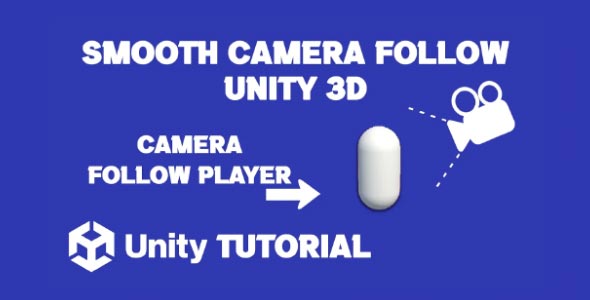In this guide, we’ll explore the concept of camera follow player Unity 3d, focusing on how to implement and refine a follow camera that keeps players engaged and provides the perspective they need to fully enjoy your game. A camera that properly follows the player ensures consistent visibility, better control, and a polished user experience in any 3D environment. Also keep in mind, creating a dynamic and responsive camera system is essential for delivering a smooth and immersive gameplay experience.
Whether you’re building a third-person adventure, an action RPG, or a driving simulator, understanding how to make your camera track the player fluidly is a key skill. Many Unity developers struggle to strike the right balance between responsiveness and stability, especially in 3D environments with varied terrain or fast-paced gameplay. This article will break down the principles and best practices for developing a solid follow camera in Unity.
Follow Camera Unity 3D
One of the most common requirements in games is a follow camera Unity 3d setup, where the camera smoothly tracks the player’s movement and rotation. This helps players maintain their orientation in the game world and keeps them focused on the action. The key to designing an effective follow camera is to ensure it feels natural, responsive, and unobtrusive.
In a camera follow setup, the camera is typically positioned behind or above the player, maintaining a certain distance and angle. This perspective gives players clear visibility of their character and the surrounding environment. The camera should respond smoothly to the player’s movement while avoiding sudden jerks or disorienting shifts. Implementing damping, lag smoothing, and collision handling can significantly improve the quality of your camera behavior.
Different genres will require different camera behaviors. For instance, in a racing game, the camera might need to lock behind the vehicle, while in an exploration game, it might need to orbit freely. Regardless of the approach, maintaining player visibility and spatial awareness is the primary goal of a good follow camera system.
Unity 3D Camera Follow Player
When designing a Unity 3d camera follow player system, it’s important to consider how the camera interacts with the game environment. Terrain elevation, obstacles, walls, and fast directional changes can all impact the camera’s effectiveness. The camera should adapt in real time, adjusting its position and rotation to maintain a clear line of sight to the player character.
A Unity camera follow feature should be robust enough to handle unexpected scenarios, like the player walking into a tight corridor or jumping across wide gaps. Good camera systems take these challenges into account and apply strategies like zooming in, tilting up, or repositioning to maintain visibility without clipping through objects.
Camera collisions are another common issue in 3D games. If the camera passes through walls or gets stuck behind geometry, it breaks immersion and frustrates players. To avoid this, many developers use raycasting or spherecasting techniques to detect and respond to potential obstacles. This way, the camera remains in a functional position even in cluttered environments.
Key Elements Of A Good Player Follow Camera
There are several essential components that go into a smooth and intuitive camera follow player Unity 3d system:
-
Target Tracking: The camera must accurately track the player’s position and movement. Whether your game is fast-paced or slow and exploratory, the camera should feel like it’s naturally attached to the player’s actions.
-
Smooth Damping: Instant camera adjustments can feel jarring. Smoothing out camera transitions using interpolation or damping ensures that the camera moves fluidly as the player navigates the world.
-
Adjustable Offsets: Different games and camera styles require different offsets. Allowing horizontal, vertical, and depth offsets lets developers fine-tune the view for optimal gameplay and aesthetics, making the follow camera Unity 3d adaptable to a variety of game scenarios and player preferences.
-
Rotation Handling: In third-person games, the camera may need to rotate with the player or be independently controlled by the user. Balancing rotation sensitivity and responsiveness improves control and immersion.
-
Obstacle Avoidance: The environment should not interfere with the camera’s function. Collision detection and adaptive repositioning help the camera maintain a clear view without disrupting gameplay.
Best Practices For Unity Camera Design
Designing an effective Unity 3d camera follow player system goes beyond just following the target. It’s about anticipating what players need to see and responding accordingly. One best practice is allowing camera flexibility—letting players adjust their view with analog sticks or mouse input. This enhances player agency and comfort.
Another practice is to test camera behavior in diverse environments. Don’t just build for flat ground—consider hills, stairs, narrow spaces, and fast changes in direction. Testing in a variety of gameplay scenarios ensures your camera system is reliable across your entire game.
Performance optimization also plays a role. Ensure your camera logic is efficient and avoids unnecessary computations per frame. Keeping it lightweight will help your game run smoothly, even on lower-end hardware.
Adapting The Camera To Game Genre
Not all follow cameras are created equal. Different genres require different types of camera behavior. For example, in action RPGs, the camera may need to prioritize combat visibility, panning out during fights and zooming in during exploration. In contrast, platformers may require a camera that locks vertically but offers horizontal tracking to highlight movement.
Understanding the core mechanics of your game will help shape the behavior of your camera follow player Unity 3d system. Consider whether the player needs to look ahead, maintain focus on an enemy, or stay centered during exploration. Tailoring the camera to these needs enhances the overall experience and reinforces the gameplay style.
Player Follow Camera In Multiplayer Or Co-Op Games
Multiplayer games introduce unique challenges for a follow camera Unity 3d system. If two players share the same screen, the camera must account for both positions and adapt accordingly. Strategies such as dynamic zooming, split-screen views, or leader-following systems are often used to address this.
In networked games, camera logic might also need to differentiate between local and remote players. Typically, the follow camera should only be active for the local player, while remote players are viewed from other angles or via spectator cameras. These details are critical to maintaining consistent player control and immersion.
Future-Proofing Unity Camera System
As your game evolves, your camera system may need to support new features like climbing, flying, or interacting with vehicles. A flexible camera architecture allows you to layer new behaviors without rewriting the core system. Modular design and clean separation of responsibilities ensure scalability and maintainability.
When developing a Unity 3d camera follow player system, it’s helpful to plan for camera modes—such as cinematic views, dialogue cameras, or special action sequences. This gives your game a more dynamic and professional feel, elevating the overall presentation.
Conclusion
A polished follow player camera system is an essential part of any successful 3D game. It provides the player with a clear perspective, enhances control, and ensures a more immersive experience. By focusing on smooth movement, collision handling, genre-specific adjustments, and scalability, you can build a camera system that supports both gameplay and storytelling.
From implementing basic tracking to handling complex camera behavior in multiplayer environments, the design of your camera follow player Unity 3d solution should always prioritize the player’s point of view. When done well, a great camera system goes unnoticed—letting the gameplay take center stage while supporting it from the background.
Camera Follow Player Script Unity
using UnityEngine;
public class CameraFollow : MonoBehaviour
{
public Transform player; // The player's transform
public Vector3 offset; // Offset position from the player
public float smoothSpeed = 0.125f; // Speed at which the camera follows
void LateUpdate()
{
if (player != null)
{
// Calculate the desired position
Vector3 desiredPosition = player.position + offset;
// Smoothly interpolate between the camera's current position and the desired position
Vector3 smoothedPosition = Vector3.Lerp(transform.position, desiredPosition, smoothSpeed);
// Update the camera's position
transform.position = smoothedPosition;
}
}
}One of the most essential aspects of a 3D game in Unity is ensuring that the camera follows the player smoothly, keeping the action centered and immersive. As you focus on camera systems, it’s also helpful to consider enemy behaviors, like those in Enemy Follow Player Unity 3D, which can interact closely with your camera dynamics.


